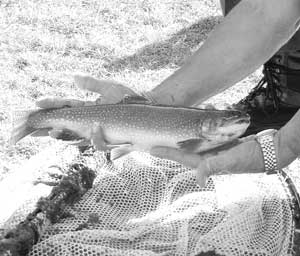
North Carolina has approximately 4,000 miles of trout waters spread across 25 western counties, and during 40 years of fishing, I’ve fished at least two-thirds of those streams. What I discovered is this state has some great trout streams. We have our share of marginal waters, too, streams littered with trash, silted by construction runoff, stripped of riparian cover, and polluted by the inevitable results of human occupation.
Fortunately, the majority of the good streams are in the national forests, national park and state parks, which means they are guaranteed (for now) some protection.
Picking the best of anything is a futile, if not foolish, exercise. So don’t consider this a list of the best, merely one trout fisher’s list of streams that every dedicated trout angler should fish at least once.
A warning — these streams are so good, you’ll undoubtedly return.
Bradley Fork: Winding through the Great Smoky Mountains National Park, this stream is the largest tributary feeding the Oconaluftee River.
The stream runs through Smokemont Campground in the park and has good access from a road and trail that run alongside the stream.
At the upper section, rainbows dominate, but in the lower section around the campground, the stream has some good-sized brown trout.
A medium-sized stream, Bradley Fork has numerous pools, cascades, and open stretches of flat water. The farther upstream you go, the better the fishing.
Access is off Newfound Gap Road (U.S. 441), about 6 miles north of Cherokee. A parking area for fishers is at the far end of the campground.
Cataloochee Creek: In the Haywood County section of the Great Smoky Mountains National Park, Cataloochee Creek offers a nice mix of rainbow and brown trout and occasional brook trout that either are swept or migrate downstream.
A road follows the stream most of its course, providing easy access to the water.
Although a medium-size stream, Cataloochee has plenty of open water for unobstructed casting.
A few big browns (10-12 inches) occasionally are caught, but most of the trout are in the 7- to 8-inch range.
Best times to fish Cataloochee are spring and fall.
Big bonuses of this trip are the beautiful former farm valley (a smaller version of Cades Cove), a lovely campground, and a resident herd of elk.
Access is from I-40 West. Take Exit 20, turn left at U.S. 276 and turn right at Little Cove Road. Follow the signs to the park.
Davidson River: North Carolina’s best known trout stream, the Davidson River draws heavy angler traffic, but it’s a stream no dedicated trout angler should miss.
It shows up consistently among lists naming the top trout waters in the nation, and its reputation is well deserved.
Davidson River is regulated as fly-fishing only, catch-and-release waters, so anglers can expect to encounter trophy-sized trout, browns and rainbows.
The biggest fish, some 20 inches and longer, usually are caught in the dead of winter when fewer people are on the stream.
The lower section of the stream, from Avery Creek to the French Broad River, is hatchery-supported waters. The stream is in the Pisgah National Forest near Brevard on U.S. 276.
Deep Creek: Also in the Great Smokies Park, Deep Creek has the reputation of being one of the state’s top brown trout streams.
In some of the large pools, fishers often see browns 20 inches and longer. The creek also has a good population of rainbows.
It’s a large stream that offers a wide variety of fishing conditions — large pools, long, ripply runs, plenty of pocket water, and adequate space for long casts.
The lower section of the creek, downstream from Indian Creek, is a popular tubing destination in the summer. Walk about 4 miles upstream, and you’ll likely have the stream to yourself.
Access is at Deep Creek Road from downtown Bryson City in Swain County.
Hazel Creek: One of the storied trout streams of the southern Appalachians, Hazel Creek is a remote trout fisher’s paradise. The only access is by boat or by foot.
A gravel road runs along the lower portion, and a well-maintained trail follows the creek the remainder of its 15-mile length.
You can expect to consistently catch rainbow trout in the 8-to 10-inch range. In some of the larger pools, such as Brown Hole, trout fishers have caught browns that weighed nearly 10 pounds.
Easiest access is by boat, either from Fontana Marina at Fontana Village Resort in Graham County, or Cable Cove, a nearby campground managed by the U.S. Forest Service.
Marina operators will drop you off and pick you up for a fee. You can take your own boat over from the public boat access at Cable Cove.
Tuckasegee River: North Carolina has 16 delayed-harvest streams, and the Tuckasegee River in Jackson County is the best and most popular.
The Tuck is a big stream and can handle crowds.
The 4-plus-mile section between the bridge at U.S. 107 near Western Carolina University and the dam at Dillsboro is heavily stocked with trout during the spring and fall.
The majority of the trout are 10-plus inches, but the Wildlife Resources Commission also stocks a number of trophy-sized brood trout. An equal number of brook and rainbow trout are stocked along with a lower number of brown trout.
The stream is catch-and-release between Oct. 1 and the last Friday in June. During this time, only artificial lures or flies with a single hook may be used.
Starting the first June Saturday, the stream operates under hatchery-supported rules.
If you need to hone your fly-fishing skills or if you just want to catch a bunch of trout, head for the Tuck
The river has good access from North River Road and South River Road. The stream also can be floated with rafts, drift boats, and canoes.
If these aren’t the best streams that western N.C. has to offer, they’re among the best.
Either way, you’ll be adequately rewarded.




Be the first to comment